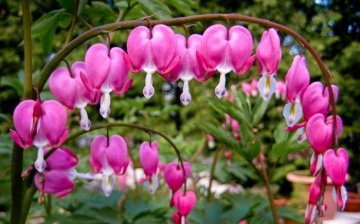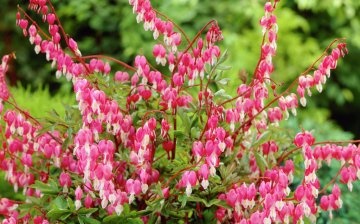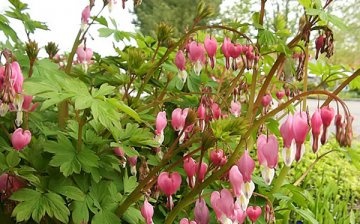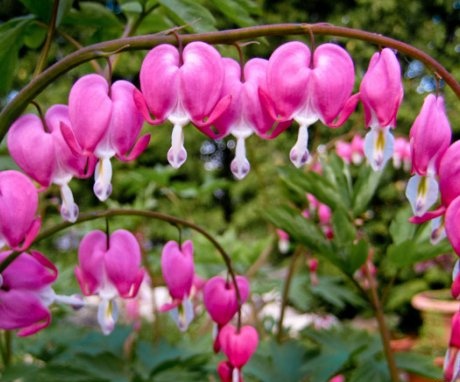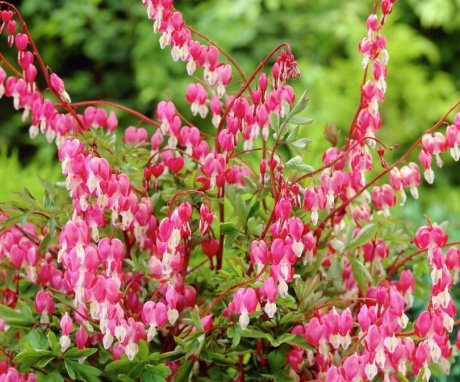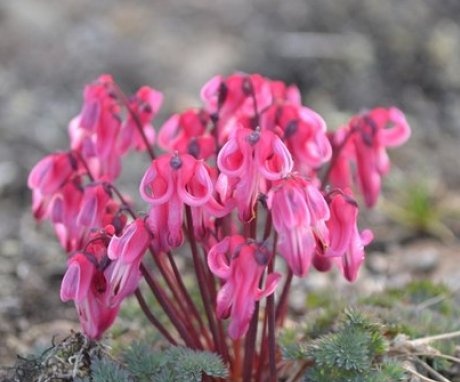Dicenter: rules for planting and caring for a plant
Dicenter is perennial an ornamental plant that belongs to the smoky family. East Asia and South America are considered her homeland, but she came to Europe from Japan. Since then, the popularity of the plant has grown every year, and now it can be found in many gardens and parks.
Content:
- General information about the plant
- Types and varieties of dicentra
- Plant care
- Reproduction of dicentra
- Diseases and pests
General information about the plant
Features of the structure of the dicenter:
- Dicentra bushes, depending on the variety, grow 30–100 cm in height.
- Its branches are spreading, medium in cut diameter, branching weakly.
- Leaves located on petioles grow sparsely along the stems. Their color depends on the type of plant. Their shape is feathery.
- Long inflorescences are formed at the edges of the branches, where the buds are arranged alternately. When unfolded, they hang down like earrings.
- The flower itself resembles a heart cut from below, from which blood flows. Their color depends on the type of plant.
- The fruits resemble boxes in shape. They contain seeds that are suitable for planting for 2 years.
- The roots of the plant are fleshy, strong, growing from the main rhizome, which goes deep into the ground.
- Almost all varieties tolerate cold well and are unpretentious in care.
Dicenter is often used in landscape design... Low-growing ones are planted along the curbs and, when flowering, create openwork edges for the paths. High bushes usually used as centerpieces or accent plants.
Many varieties have a long flowering period, some bloom in June and do not stop delighting until the first frost.
The decorativeness and delicacy of the leaves are also involved in the landscaping of the site. The plant can be used alone or combined with other flowers or bushes. If the different varieties are planted correctly, the colorful bloom will be throughout the season.
Types and varieties of dicentra
The most popular varieties of dicentra:
- The center is magnificent Alba. The bush is large, the branches extend 70 cm in height. The shape of the bush is neat oval. The variety is valuable for its long flowering period, which lasts about 3 months. The leaves are feathery, painted in a green tone with a bluish tinge, densely located on the branches. The flowers are small in size, sparsely located on the inflorescence, have the shape of a heart with a drop, painted in a white tone. The variety is frost-resistant and grows equally well both in a sunny place and in partial shade.
- The center is magnificent GoldHeart. This variety is tall, the branches of the bush are stretched 100 cm in height. The leaves are dissected, painted in a yellowish-golden tone, have a decorative appearance. The bush attracts attention and is very beautiful both during flowering and after and before due to the decorativeness of the leaves. The flowers are large, heart-shaped with a drop. Painted in pink with a white-pink drop.
- The gorgeous Valentine's center. This variety has a rich cherry color. The bushes are large, branching, up to 100 cm high. The leaves are openwork, feathery, painted in a bright green tone. The flower drops are colored white and pink.
- The bleeding center is beautiful Aurora. Varieties of this species have undersized bushes. Its branches are stretched 40 cm in height. The leaves are beautiful, feathery, delicate, painted in a green tone.The flowers are completely white with a slight pink at the end of the drop.
- Dicenter beautiful SpringMagic. The bushes are not tall, the branches are extended by 40 cm. The bushes are spreading, oval. A distinctive feature of this variety is the color of the leaves - silvery. This gives the bush a special charm. It goes well with other varieties. Frost resistant.
- The bleeding center is beautiful Bacchanal. The plant stretches branches to a height of 40 cm. Stems are medium-sized, spreading, forming an oval bush. The leaves are feathery, openwork, painted in a green tone. The flowers are large, heart-shaped, painted in a bright red, rich tone. The drop is small and has a light pink color. The variety tolerates cold well, is unpretentious in care.
- The center is exceptional. The bushes of this variety are quite low. Their height reaches only 25 cm. The leaves look like a fern, they are painted in a green tone. The main advantage of the dicentra is its exceptional flowering duration, which can last until frost. Also, this species tolerates heat well, so it is often used in open areas and as a curb plant. Medium-sized flowers are located on a drooping peduncle. They are painted in white or pink tones.
- The dicenter is climbing. This variety is radically different from its counterparts. Dicenter climbing is a liana-like plant. Its branches can stretch up to 2 meters and spread along the ground. If there is support, the stems twine around it, creating a beautiful vertical bush. The leaves are painted in a green tone, in appearance they resemble pea leaves: three oval leaves are collected on one petiole. The inflorescences are drooping, the petals of the flowers are yellow. In cold regions, it is grown as an annual, as it does not tolerate cold well. It adjoins well with other plants, including climbing ones.
- Dicenter vagrant Burning Hearts. This variety is the lowest among all the others. The height of its branches barely reaches 15 cm. Despite this, the plant is a long-liver. Its flowers are large enough, bright red saturated color. The leaves are small, delicate, of medium density. Painted in a silver tone.
Plant care
Such a plant as a dicentra, landing and care for which it is not difficult, is popularly known as a "broken heart". By giving it a little time and attention, gardeners and florists will get a wonderful decorative bush, the flowering of which will attract attention and decorate the territory. Some varieties have not only beautiful flowers, but also decorative leaves. Therefore, the bushes look beautiful throughout the summer season.
The dicentra plant is not demanding on lighting and grows well and blooms both in the sun and in partial shade and shade.
But it should be borne in mind that receiving less sunlight, the plant will bloom less, and the color of the petals will be slightly muffled. At the same time, in the sun, the flowers will be bright, the flowering duration is longer. The soil is preferable light, fertile with good drainage. Slightly acidic soils work well.
Transplant and it is recommended to plant a dicenter in the autumn. To do this, a hole is dug in the chosen place, the diameter of which should be at least 50 cm, so that the well-developed roots of the plant fit freely in it. It is recommended to lay drainage on the bottom, and fertilize the earth with humus. Also, if the soil is heavy, peat, deciduous soil and river sand must be mixed with it. The well is filled, watered well with water and allowed to brew for several weeks. So if landing is scheduled for the fall, then at the beginning of the month a place is being prepared, and at the end of the month there is a disembarkation. With a spring planting, the hole stands all winter. It is recommended to plant the plant so that the branches are well blown with air. If the bush becomes very thick, it is easily affected. diseases.
Watering plants:
- Water the plant sparingly, but the roots should not dry out.
- In hot weather, after watering, it is recommended to mulch humus soil. This will provide additional nutrition to the plant, as well as prevent rapid evaporation of moisture.
- After watering, the ground around the bush is loosened and removed regularly weeds.
- It is also necessary to ensure that excess moisture does not collect near the roots, and the soil does not become waterlogged, as the roots can rot.
Dicenter is fed in the spring. Suitable for this mineral fertilizers... They are brought in 2-3 times in the spring months. In the autumn season, the plant is prepared for wintering. It is necessary to cut off the ground part, leaving 4 cm from the ground, and insulate the roots with peat or humus. Almost all varieties of dicentra tolerate frosts well, therefore, it is also not recommended to insulate the roots too much.
Reproduction of dicentra
Reproduction dicenter can be carried out using seed, basal cuttings and dividing the bush... Reproduction using seeds is a rather painstaking work. In order for them to sprout and grow strong and healthy, you must follow some rules. Initially the seeds sown in containers with loose, light fertile soil and transferred to a bright room, where the temperature is maintained within 18-20 degrees. Shoots should appear in 3-4 weeks. After another week, shoots can be dive in open ground and insulate well for the winter.
You can cover it with peat or humus, or build a small greenhouse.
Such bushes grow and begin to bloom only in the third year. Collected the seeds it is recommended to plant in the same year, purchased have an expiration date.
Basal cuttings the dicenter can be propagated in the spring. To do this, when shoots with a height of 7-10 cm have appeared, the earth is carefully raked away from the rhizome near the sprout and cut off along with a piece of root. It is recommended to root such a daughter bush in the shade, having mulched it well. After a while, the root will give new shoots. You can transplant the plant to a permanent place only the next year. Many gardeners recommend rooting such cuttings in greenhouses. This method is justified if the spring is cold.
Tips for breeding dicentra by dividing the bush:
- Reproduction by dividing the rhizome can be carried out when transplanting a bush. This process is carried out once every 5-6 years.
- If the bush is left in the same place for longer, its old roots will start to rot and spoil the young, which can lead to the death of the entire plant.
- For transplants the roots are carefully dug out and divided so that 3-4 shoots remain on each new formation. It is recommended to carry out such a transplant in the autumn.
- New holes are being prepared, the diameter of which should be at least 40 cm.
- Ready-made roots are placed in 3 pieces in one hole at a distance of 30-40 cm. Such a planting will give a lush bush in the spring.
- If in the fall it was not possible to plant the dicenter, this process can be carried out in late March or early April, when the plant is still in a drowsy state.
- Digging and dividing the roots must be done very carefully, as they are brittle. Some recommend drying the roots a little before dividing so that they become a little soft. In this case, there is a threat to ruin the shoots.
When breeding dicentra, do not forget that its juice is poisonous. If it comes into contact with the skin, it is absorbed into the body and can lead to unpleasant consequences. Therefore, all procedures associated with dividing the rhizome or cutting off cuttings must be carried out with gloves.
Diseases and pests
Diseases at the dicenter appear when the wrong care... If you constantly overmoisten the soil and do not plant the plants in time, the roots begin to rot, the leaves wither and the bush disappears. It is also not recommended to plant the dicenter too densely.
Basically, the plant is quite resistant to disease.
However, sometimes the plant needs treatment. Ring spot and microplasma disease damage the shrub.For treatment, all branches are removed, and the roots are removed, cleaned of soil and washed in a solution of potassium permanganate. The soil is disinfected with a weak formalin solution. The roots can be planted in their original place only after a month.
It is also recommended to regularly review and if necessary to process dicenter with drugs for aphids, which can also carry diseases.
More information can be found in the video.




